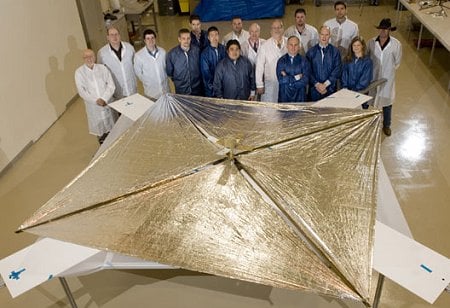NASA’s Marshall and Ames Research Centers will team up with the commercial space company SpaceX to launch and deploy a solar sail this summer. A bread-box sized payload called NanoSail-D will travel to space onboard a SpaceX Falcon 1 Rocket and if all goes well, it will be the first fully deployed solar sail in space, and the first spacecraft to use a solar sail as a primary means of orbital maneuvering. The first launch window is from July 29th to August 6th, with a back-up window extending from August 29th to September 5th. Weighing less than 4.5 kilograms (10 pounds) the aluminum and plastic sail has about 9.3 m² (100 square feet) of light-catching surface which researchers hope will successfully propel the spacecraft.
Solar sails have been the stuff of dreams for years. Because there's no friction in space, once a solar sail starts moving, it can go on forever. While rockets would run out of gas and begin to coast, a spaceship powered by solar sails would continue accelerating as long as there is a solar wind, reaching faster speeds and covering distances far greater than any rocket. No rocket has been invented that could carry enough fuel to reach the outer solar system in as short a time. And like a marine sail, a solar sail could also bring you home. You could use the solar sail to travel "against the wind," back to Earth.
"It's not so much about how far a sail will go compared to a rocket; the key is how fast," says Edward "Sandy" Montgomery of NASA's Marshall Space Flight Center. "The Voyagers have escaped the solar system, and they were sent by rockets, but it's taken more than three decades to do it. A sail launched today would probably catch up with them in a single decade. Sails are slower to get started though. So, for example, between the Earth and the moon, rockets might be preferred for missions with a short timeline. It's a trip of days for rockets, but months for a solar sail. The rule of thumb, therefore, would be to use rockets for short hops and solar sails for the long hauls."
Previous attempts to launch and deploy a solar sail in space have met limited success. In 2004 Japan launched prototype solar sails that deployed, but they weren’t used for propulsion. The Planetary Society attempted a solar sail launch in 2005, called Cosmos 1, but the Russian launch vehicle failed to reach orbit. NASA did successfully deploy a solar sail in a vacuum chamber in 2004, but of course, its propulsive capability wasn’t able to be tested.
Montgomery believes a successful mission would be huge for the future of spaceflight. If successful, solar sails could potentially help with a growing problem of space debris.
"Currently, micro-satellites in orbit above a few hundred kilometers can stay in orbit for decades after completing their mission," Montgomery said. "This creates an orbital debris collision risk for other spacecraft. NanoSail-D will demonstrate the feasibility of using a drag sail to decrease the time satellites clutter up Earth's orbit. Although our sail looks like a kite, it will act like a parachute (or like a drag sail) in the very thin upper atmosphere around Earth. It will slow the spacecraft and make it lose altitude, re-enter the Earth's atmosphere and burn off in a relatively short period of time. A drag sail is a lighter alternative to carrying a propulsion system to de-orbit a satellite."
Movie of how NanoSail D will unfurl.
Original News Source:
Science at NASA
 Universe Today
Universe Today
